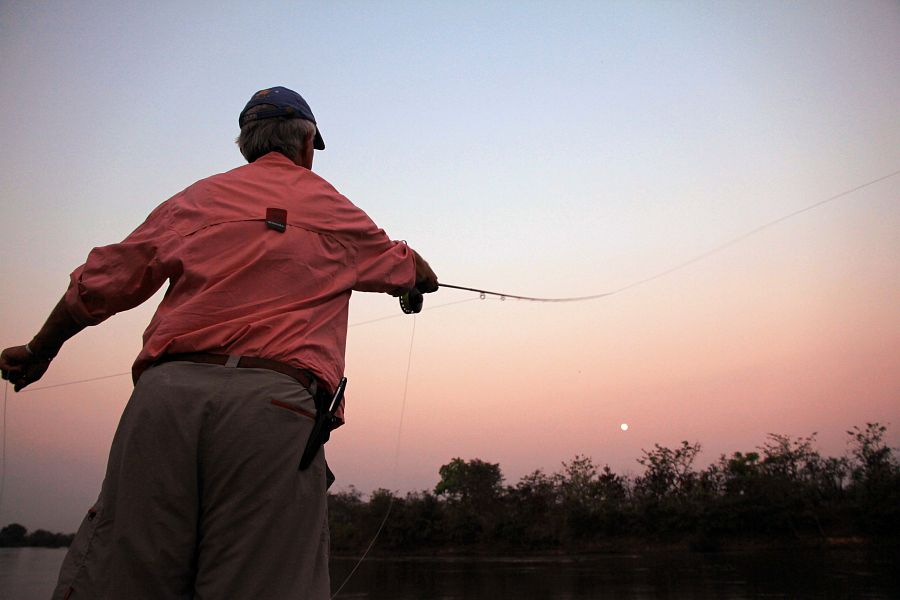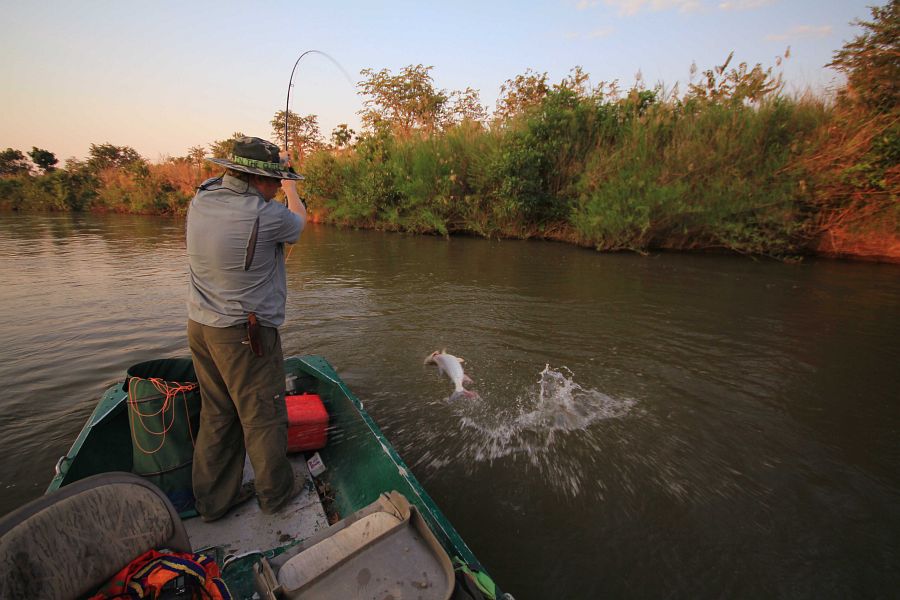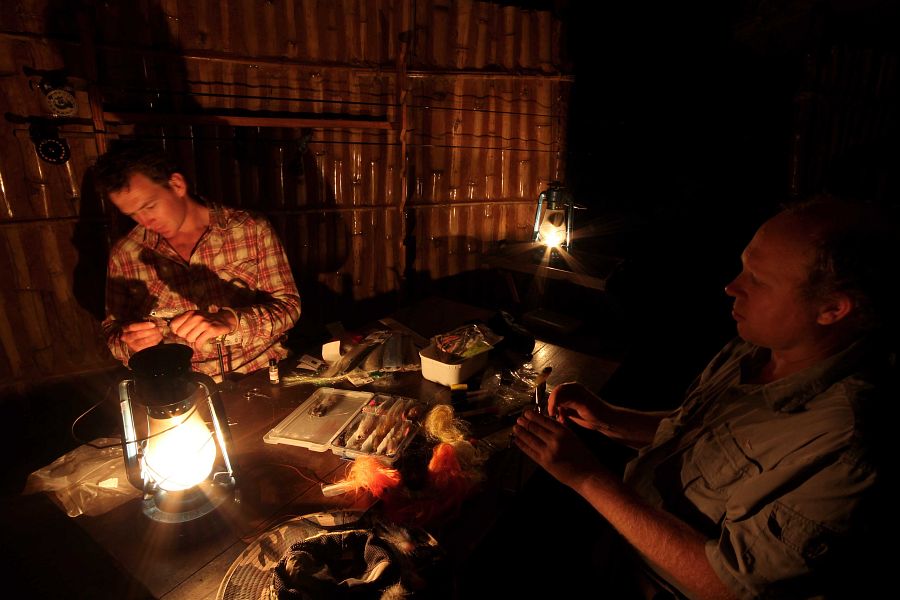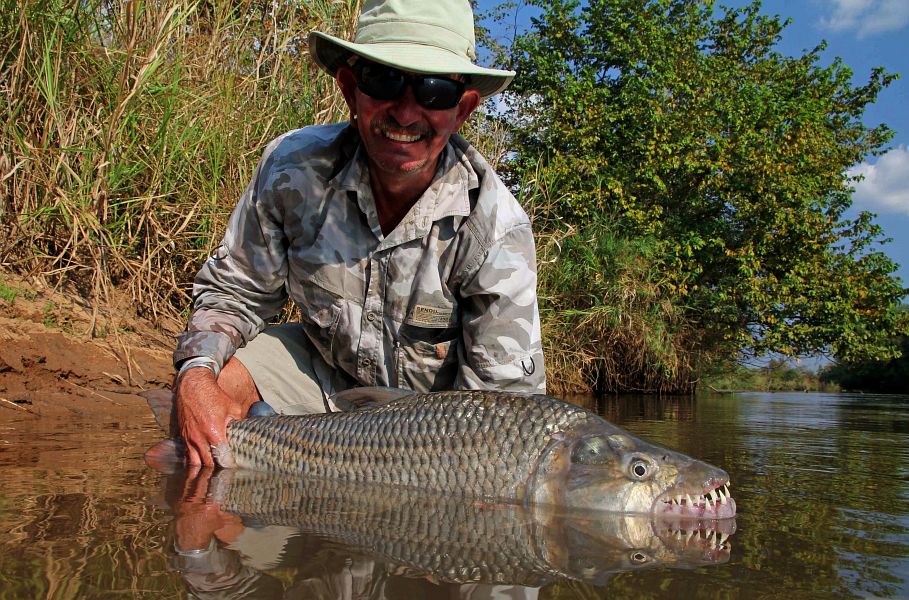Trophy Tigers from the Dark Continent
Leonard Flemming
The general assumption that fishing depends on luck by and large is despised by those who take their piscatorial hobby seriously and although I am one of those who believe “the more you practice the luckier you get”, I would have to confess that there are some fish that require a higher percentage of luck than skill. Tigerfish in Africa are one of those fish species so exceptionally hard to land any venture for trophy fish could well end up in tears. Enough to make grown men cry? Well, almost. But don’t not get me wrong. I’m not referring to 2 to 10 pound tigers that make up the bulk of your usual catch; I’m talking tigers over 16 lb!

Graham Roberts hoisting 20 pounds of titanic Tanzanian tigerfish
Although tigerfish species are widespread across the Dark Continent, rivers that support fish more than 16 lbs are hard to find. You may get lucky on the Zambezi with a 16 lb tiger, but the vast expanse of its flow and the limited number of big fish in this system makes it a difficult task. To increase your odds of hooking a trophy tigerfish you need to travel much deeper into the tropics of Africa.
Several years ago, around 2008, the rumours of 20 lb tigerfish in the Kilombero Valley, Tanzania, became a reality when Keith Clover of Tourette Fishing landed a 23 lb tiger on fly tackle. The Kilombero catchment, consisting of the Mnyera and Ruhudji Rivers, is now renowned for large tigerfish, with regular catches over 20 lbs, even fish up to 26 lbs, setting the benchmark for trophies in the 20 lb class.

Ed Kozlowski pushing a long cast at last light
It is a remote destination, beautiful beyond description. In fact, it fits the dream description of the fishery you ever so often drift off to sitting behind your office desk. This, though, is a place you actually drift through skyscraper-tall fig trees and water berries covered in woven sheets of tassel pods. The thickets teem with colourful insects, birds and animals, including lions and elephants. Even the rivers boil with life and besides a colourful blend of fish species there a few dangerous numbers, like crocodiles and hippos. Animal tracks on the sandy riverbanks are a constant reminder of the danger that lurks close by in the miombo woodlands.
The rivers themselves are log-strewn, creating the most tantalizing structure haunted by big tigers. Here and the you will see fleeing baitfish scurrying up mossy logs or steep clay banks to escape the slashing thrusts of marauding tigerfish. Somewhat prehistoric in appearance, these tigers are top rate predators with gaping mouths filled with shark-like teeth that can cut to the bone if not handled with care. They fall into a class of their own and compare to nothing else that swims the sweet waters of our planet. People often like to compare them to dorado, but are quickly silenced by the ferocious takes and incredible speed, power and length of the runs. They may both be large characins, inhabit near identical waters, and even have phenotypic similarities, but the proof lies in the catching and it’s here where the tiger stands out. Hence, given the remoteness of this place, the ferocity of the tigers themselves and the dangerous animals that share your space, it’s understandable that these tigerfish trips are not for the faint hearted!
Tackling trophy tigers: getting down and dirty
Tourette Fishing guides will point out lay-downs and log-jams in deep channels which require accurate presentations with the fly. Fast strips induce the most strikes, which often catch you by surprise on the change of angle of the fly near the boat. Once successfully hooked, a fierce struggle follows with powerful runs at uncontrollable speed and aerial displays of bone and teeth gnashing at your wire trace. Most battles end with a thrown hook or a log-wrap, but every now and then a fish manages to cut through the #4 piano wire or engulfs the fly and slices the leader. So how do you land these fish?

Deadly baitfish patterns for Tanzanian tigers
I spent four months in this area guiding the fishing season, which covers the months of July to early November, while collecting samples of fish for scientific purposes and was frequently asked for my opinion on technique to land trophy tigers. Three general tips repeatedly came to mind; firstly, you need to be in a relaxed state of mind and not rush the casting, which sounds ridiculous I know, but you really need to calm yourself down; secondly, cast accurately at structure, hence tip no. 1 – do not rush the cast!; and thirdly, get down and dirty, bully these fish and you will land more! Strip strike as hard as possible, or rather as hard as your 30 lb leader will allow you to set the hook on any “touch” on the fly. When I say touch, I mean anything, even if it means burying the hook tip deep into a log, since big fish are often mistaken for logs. Besides that, one should not get too technical about tackle; beef up and you will beef up on fish size. Guaranteed! These are serious fish in fast flowing water littered with trees, hook them hard and pull them hard and you may get lucky and land one. I have seen it all, from experienced fly fishermen with theories of their own, to businessmen that strike them hard and haul them in. So which are more successful? To be honest, the businessmen enjoy the fishing more, simply because they come to have fun, are more relaxed and land more big fish. Even I got lucky enough to land a 24 lb tiger on fly, an attribute to Rob Scott’s (head Tourette Fishing guide) expertise and the four months I spent guiding in the area. The fish was barely in the net and the size 4 big game hook dropped out of its bony jaws.

Ed Truter doing battle with a hooked tiger
The bottom line is that tigerfish, especially these big Tanzanian subspecies (Hydrocynus tanzaniae), have thick bony jaws and hooks just do not penetrate. Part of the reasoning for fighting them hard and keeping contact at all times is to maintain maximum pressure on the hook tip. Slack line or a sudden change in angle may cause the hook to drop out of its hold on the bone.
As you may have gathered, tackle is selected on a trial and error basis. Most rods pop like match sticks and fly lines get stripped, or knot and fall apart. A selection of 9 and 10 wt rods loaded with fast sinking (300-350 grain) shooting heads will see you through a week of chaotic line hauling and rod strikes. Yes, rod strikes! The initial hook set is manifested by a hard and controlled strip strike. This rarely penetrates the hook and hence, a series of rod strikes by palming the cork seat hard on a tight line is recommended to secure the hook. Although an essential part of the fight, this is where I’ve seen most rods snap. Surprisingly, most fish are still landed with broken rods while the hook is set so deep in the bone that you need two sets of pliers to release the fish.

Rob Scott and Ed Truter tying flies at lamplight in Tengo Camp
Although line control remains problematic, it can be solved to a degree by using a quality fly line (with a good running line) loaded onto a large arbor reel with a smooth and durable drag system, and stripping into a collapsible laundry basket with a wet towel to lubricate the running line. Besides protecting your fly line, lubrication will also protect your fingers. The most common injuries onboard consist of a combination of teeth marks and line burns on the fingers and although a Boga Grip may prevent the former to a degree, line burns are still common in the tropical heat (which often exceeds 40 degrees Centigrade) and the tiger mayhem of central Africa!
Concluding remarks

John Travis with a tremendous 21 lb tiger from the Mnyera River
As one of the few recognized native sporting fish of this continent, tigerfish are among the top of freshwater sport fish in the world. I guess the only question in your mind should be whether tigers are worth traveling half way across the planet into remote Africa for? Tanzania is a beautiful country with more than 120 indigenous tribes, each with their own dialect of Kiswahili. Moreover, it is one of the last frontiers which offer wild African animals in their natural habitat. The countryside varies from wild rural towns situated in grasslands to hills covered in several different biomes of miombo woodland, while tropical rainforests are found in the near unpopulated highland gorges. It is from the highlands that the Mnyera and Ruhudji Rivers drain and it is in such aesthetically beautiful areas where trophy tigers come to the fly. Additionally, many other interesting and colourful fish species, such as the infamous rhinofish (a large yellowfish species), coexist with H. tanzaniae in these rich aquatic ecosystems, making for an interesting trip fly fishing wise. So my answer would be, indeed, these tigers are worth it!
For more information on trophy tigers in Tanzania, visit www.tourettefishing.com or contact Keith Clover or Rob Scott on e-mail: This email address is being protected from spambots. You need JavaScript enabled to view it., or phone 0027 84 622 2272.


